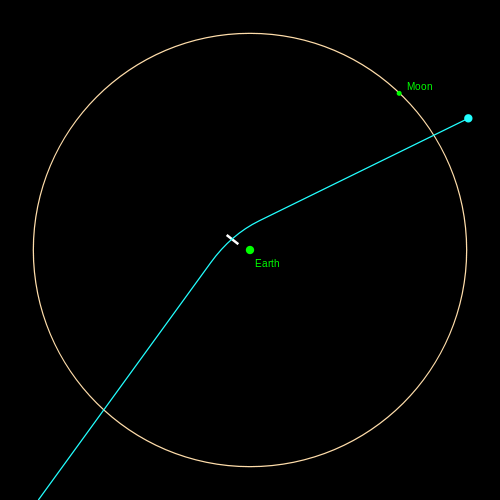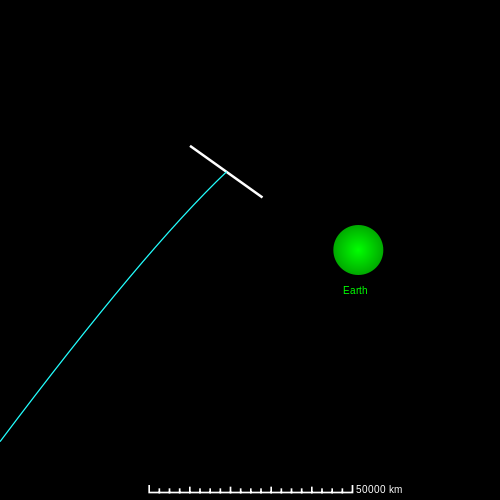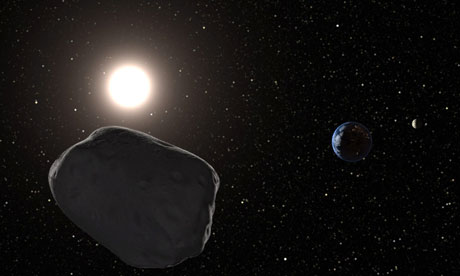I have posted several stories on End of the World scenarios. Mostly they are amusing fantasy or disturbing portrayals of abnormal human psychology. Sometimes there are true threats that must be monitored closely as Javier reported in 2011, and while Apophis is not a world ender, it is certainly a potential world changer.
I will let the professionals take over from here.
From The Guardian
Apophis hit the headlines in December 2004. Six months after its discovery, astronomers had accrued enough images to calculate a reasonable orbit for the 300-metre chunk of space rock. What they saw was shocking.
There was a roughly 1 in 300 chance of the asteroid hitting Earth during April 2029. Nasa issued a press release spurring astronomers around the world to take more observations in order to refine the orbit. Far from dropping, however, the chances of an impact on (you’ve guessed it) Friday 13 April 2029 actually rose.
By Christmas Day 2004, the chance of the 2029 impact was 1 in 45 and things were looking serious. Then, on 27 December astronomers had a stroke of luck.
Looking back through previous images, they found one from March on which the asteroid had been captured but had gone unnoticed. This significantly improved the orbital calculation and the chances of the 2029 impact dropped to essentially zero. However, the small chance of an impact in 2036 opened up and remains open today.
From JPL/NASA.gov
The future for Apophis on Friday, April 13 of 2029 includes an approach to Earth no closer than 29,470 km (18,300 miles, or 5.6 Earth radii from the center, or 4.6 Earth-radii from the surface) over the mid-Atlantic, appearing to the naked eye as a moderately bright point of light moving rapidly across the sky. Depending on its mechanical nature, it could experience shape or spin-state alteration due to tidal forces caused by Earth’s gravity field.
This is within the distance of Earth’s geosynchronous satellites. However, because Apophis will pass interior to the positions of these satellites at closest approach, in a plane inclined at 40 degrees to the Earth’s equator and passing outside the equatorial geosynchronous zone when crossing the equatorial plane, it does not threaten the satellites in that heavily populated region.

Illustrating the “Keyhole” that DeGrasse Tyson referred to in the video as Apophis passes through Near Earth Orbit. Looks like it could clip the moon too. That would be a show!

And a closer detail
Now the above statement dates back to 2007. There have been revisions and updates.
Again, from JPL/NASA.gov
2009-Apr-29:
This animation illustrates how the unmeasured physical parameters of Apophis bias the entire statistical uncertainty region. If Apophis is a RETROGRADE rotator on the small, less-massive end of what is possible, the measurement uncertainty region will get pushed back such that the center of the distribution encounters the Earth’s orbit. This would result in an impact probability much higher than computed with the Standard Dynamical Model. Conversely, if Apophis is a small, less-massive PROGRADE rotator, the uncertainty region is advanced along the orbit. Only the remote tails of the probability distribution could encounter the Earth, producing a negligible impact probability. Although measurements in 2010-2011 may cut the size of the measurement uncertainty region greatly and result in an “all clear” using the Standard Dynamical Model, it may not be until Arecibo radar in 2013 provides a spin direction that Earth’s passage through the probability distribution center can be ruled out.
What does it all amount to? Well pretty much a reiteration of DeGrasse Tyson’s statement on the video.
SUMMARY
Researchers at NASA/JPL, Caltech, and Arecibo Observatory have released the results of radar observations of the potentially hazardous asteroid 99942 Apophis, along with an in-depth analysis of its motion. The research will affect how and when scientists measure, predict, or consider modifying the asteroid’s motion. The paper has been accepted for publication in the science journal “Icarus” and was presented at the AAS/DPS conference in Orlando, Florida in October of 2007. The Apophis study was led by Jon Giorgini, a senior analyst in JPL’s Solar System Dynamics group and member of the radar team that observed Apophis.
The analysis of Apophis previews situations likely to be encountered with NEAs yet to be discovered: a close approach that is not dangerous (like Apophis in 2029) nonetheless close enough to obscure the proximity and the danger of a later approach (like Apophis in 2036) by amplifying trajectory prediction uncertainties caused by difficult-to-observe physical characteristics interacting with solar radiation as well as other factors.
We will hopefully know more soon:
The close approach in 2029 will substantially alter the object’s orbit, making predictions uncertain without more data. “If we get radar ranging in 2013 [the next good opportunity], we should be able to predict the location of 2004 MN4 out to at least 2070.” said Jon Giorgini of JPL. Apophis will pass within 0.0966 AU (14,450,000 km; 8,980,000 mi) of the Earth in 2013, allowing astronomers to refine the trajectory for future close passes. Just after the close approach on 9 January 2013, the asteroid should peak at about apparent magnitude 15.7. On January 31, 2011, astronomers took the first new images of Apophis in more than 3 years.
“Keep watching the skies”
From Homestead.com
4 commentsThe Snake-Demon Apophis (Apep)
Apophis was the great adversary of the sun Re and the embodiment of the powers of dissolution, darkness, and non-being. The huge serpent was believed to have existed from the beginning of time in the waters of primeval chaos which preceded creation and it was thought that he would continue to exist in an endlessly malevolent cycle of attack defeat and resurgent attack. The god is not attested before the Middle Kingdom [2055 BC] and seems to have come into being in the uncertain and fearful times which followed the pyramid age.Like the god Seth, Apophis was associated with frightening natural events such as unexplained darkness, storms and earthquakes as well as his underlying threat to the very stability of the cosmos, so magical texts and rituals were produced to combat these things. The so-called Book of Apophis was a collection of these magical tests and spells dating to the late New Kingdom, through the best preserved example – the Bremner-Rhind Papyrus in the British Museum – was produced in the 4th century BC.





